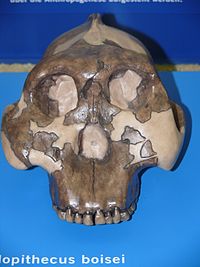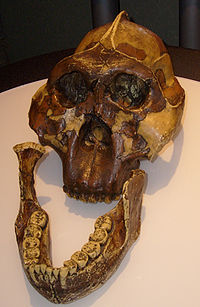- Paranthropus boisei
-
Paranthropus boisei
Temporal range: Pliocene-Pleistocene
Scientific classification Kingdom: Animalia Phylum: Chordata Class: Mammalia Order: Primates Family: Hominidae Genus: Paranthropus Species: P. boisei Binomial name †Paranthropus boisei
(Mary Leakey, 1959)synonyms - Zinjanthropus bosei
(Louis Leakey, 1959)
Paranthropus boisei (originally called Zinjanthropus boisei and then Australopithecus boisei until recently) was an early hominin and described as the largest of the Paranthropus species. It lived from about 2.6 until about 1.2 million years ago during the Pliocene and Pleistocene epochs in Eastern Africa.
Contents
Discovery
First discovered by anthropologist Mary Leakey on July 17, 1959, at Olduvai Gorge, Tanzania, the well-preserved cranium (nicknamed "Nutcracker Man") was dated to 1.75 million years old and had characteristics distinctive of the robust australopithecines. Mary and her husband Louis Leakey classified the find as Zinjanthropus boisei: "Zinj" for the medieval East African region of Zanj, "anthropus" meaning ape or ape-human, and "boisei" for Charles Boise (the anthropologists team’s funder at the time).[1] Paranthropus boisei (as the species was eventually categorized) proved to be a treasure especially when the anthropologists' son Richard Leakey considered it to be the first hominin species to use stone tools. Another skull was unearthed in 1969 by Richard at Koobi Fora near the Lake Turkana region, in Kenya.
Morphology and interpretations
The brain volume is quite small, about 500 and 550 cm³, not much larger in comparison to Australopithecus afarensis and Australopithecus africanus. It had a skull highly specialized for heavy chewing and several traits seen in modern day gorillas. P. boisei inhabited savannah woodland territories. Males weighed 68 kg (150 lb) and stood 1.3 m (4 ft 3 in) tall, while females weighed 45 kg (99 lb) and stood 1.05 m (3 ft 5 in) tall. The average adult males were much larger than females (sexual dimorphism), as was the case in virtually all australopithecine species. The back molar teeth were relatively large, with an area over twice as great as is found in modern humans.[2] The species is sometimes referred to as “Nutcracker Man” because it has the biggest, flattest cheek teeth and the thickest enamel of any known hominin.[3]
Some argue that the craniodental morphology of this taxon (e.g., large postcanine dentition, thick enamel, robust mandibles, sagittal cresting, flaring zygomatic region) are indicative of a diet of hard or tough foods such as ground tubers, nuts and seeds.[4] However, research on the molar microwear of P. boisei[5][6] found a microwear pattern very different than that observed for P. robustus in South Africa which is thought to have fed on hard foods as a "fallback resource[7]. This work suggests that hard foods were an infrequent part of its diet. The carbon isotope ratios of P. boisei suggest that it had a diet dominated by C4 vegetation.
Fossils
 Cast of the skull found by Mary Leakey in 1959 with jaw discovered by Kamoya Kimeu in 1964.
Cast of the skull found by Mary Leakey in 1959 with jaw discovered by Kamoya Kimeu in 1964.
In 1993, A. Amzaye found fossils of P. boisei at Konso, Ethiopia. The partial skull's designation is KGA10-525 and is dated to 1.4 million years old. It is the biggest skull specimen ever found of P. boisei. The oldest specimen of P. boisei was found in Omo, Ethiopia and dates to 2.3 million years old classified as (L. 74a-21) while the youngest speciemen from Olduvai Gorge dates 1.2 million years old classified as OH 3 and OH 38.
Other well preserved specimens
- OH 5 Zinjanthropus or "Zinj" or "Nutcrackerman" is the first P. boisei found by Mary Leakey at Olduvai Gorge, Tanzania belonging to an adult male (circa. 1.75 mya).
- KNM ER 406 is a small partial cranium discovered by H. Mutua and Richard Leakey in 1969 found at Koobi Fora, Kenya displays large zygomatic arches, a cranial capacity of 510 cm³ (circa. 1.7 mya).
- KNM WT 17400 a partial cranium with similar characteristics as KNM WT 17000 "Black skull" belonging to Paranthropus aethiopicus. The skull was found at West Turkana, Kenya (circa. 1.7 mya).
- ER 406 was found by Richard Leakey and H. Mutua in 1970 at Koobi Fora, Kenya is a partial cranium most likely identified as belonging to a female (circa. 1.7 mya).
See also
- List of fossil sites (with link directory)
- List of hominina (hominid) fossils (with images)
- Olduwan
References
- ^ Watson, Peter (2002). The Modern Mind: An Intellectual History of the 20th Century. New York: Perennial. pp. 486–487. ISBN 0060084383.
- ^ McHenry, H.M.; Coffing. K. (2000). "Australopithecus to Homo: transformations in body and mind". Annual Review of Anthropology 29 (1): 125–146. doi:10.1146/annurev.anthro.29.1.125. http://www.anthro.ucdavis.edu/faculty/mchenry/Aust-Homo.pdf.
- ^ Findings Challenge Conventional Ideas on Evolution of Human Diet, Natural Selection Newswise, Retrieved on June 26, 2008.
- ^ Klein, Richard G. (1999). The Human Career: Human Biological and Cultural Origins (2nd ed.). Chicago: University of Chicago Press. ISBN 0226439631.
- ^ Ungar, Peter S.; Frederick E. Grine, Mark F. Teaford (April 2008). Petraglia, Michael. ed. "Dental Microwear and Diet of the Plio-Pleistocene Hominin Paranthropus boisei". PLoS ONE 3 (4): e2044. doi:10.1371/journal.pone.0002044. PMC 2315797. PMID 18446200. http://www.plosone.org/article/info%3Adoi%2F10.1371%2Fjournal.pone.0002044. Retrieved 21 March 2011.
- ^ "Gnashers at Work". The Economist. 2008-05-01. http://www.economist.com/science/displaystory.cfm?story_id=11288491. Retrieved 2008-05-05.
- ^ Scott RS, Ungar PS, Bergstrom TS, Brown CA, Grine FE, Teaford MF, and Walker A. 2005. Dental microwear texture analysis shows within-species diet variability in fossil hominins. Nature 436(7051):693-695.|doi10.1038/nature03822
External links
Wikimedia Commons has media related to: - Archaeology Info
- MNSU
- Paranthropus boisei - The Smithsonian Institution's Human Origins Program
- The first skull of Australopithecus boisei, Gen Suwa et al., letters to nature, Nature, Vol. 389, 2 October 1997
- American Museum of Natural History illustration of P. boisei by Jay Matternes
Part of the series on Human evolution Australopithecus: A. anamensis · A. afarensis · A. bahrelghazali · A. africanus · A. garhi · A. sediba
Paranthropus: P. aethiopicus · P. boisei · P. robustusHumans and Proto-humansHomo: H. gautengensis · H. habilis · H. rudolfensis · H. georgicus · H. ergaster · H. erectus (H. e. erectus · H. e. lantianensis · H. e. palaeojavanicus · H. e. pekinensis · H. e. nankinensis · H. e. wushanensis · H. e. yuanmouensis · H. e. soloensis) · H. cepranensis · H. antecessor · H. heidelbergensis · Denisova hominin · H. neanderthalensis · H. rhodesiensis · H. floresiensis · Archaic Homo sapiens · Anatomically modern humans (H. s. idaltu · H. s. sapiens)Categories:- African archaeology
- Hominina
- Pliocene mammals
- Pleistocene mammals
- Pleistocene extinctions
- Fossil taxa described in 1959
Wikimedia Foundation. 2010.

